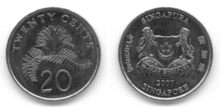Singapore dollar
| Singapore dollar | |
|---|---|
| Country: |
|
| Subdivision: | 100 cents |
| ISO 4217 code : | SGD |
| Abbreviation: | $, S $ |
|
Exchange rate : (August 24, 2020) |
1 EUR = 1.6203 SGD 1 CHF = 1.5057 SGD |
The Singapore dollar is the currency of Singapore.
The Board of Commissioners of Currency, Singapore (BCCS) has the sole right to issue banknotes and coins . The Singapore dollar is a freely traded currency that is monitored by the Monetary Authority of Singapore via a shopping cart with other currencies . Which currencies this is composed of is kept secret in order to prevent speculators from attacking the currency or from outside pressure on the Singapore dollar.
The Singapore dollar has a fixed exchange rate of 1: 1 with the Brunei dollar . The banknotes and coins of both countries are also valid means of payment in the other country.
Historical
After Singapore was excluded from the Malaysia Federation in 1965, there was a monetary union with Malaysia and Brunei for two more years . Differences over the structure of the monetary union, especially with regard to the central bank and the degree of independence, led to a break in the monetary union in 1967.
The three countries then issued their own national currencies, which were, however, pegged to the pound sterling with an exchange rate of one unit national currency = 2s 4d based on the Currency Interchangability Arrangement (CIA) . This is the reason that until 1973 the Malaysian ringgit and the Brunei dollar were also temporarily accepted in Singapore and the Singapore dollar also in Malaysia and Brunei. In 1973 the Bretton Woods system of fixed exchange rates and the gold pegging of the US dollar were abolished, causing Great Britain to devalue its currency. Malaysia took the opportunity and resigned from the CIA, so that mutual interchangeability was only maintained with Brunei.
Banknotes
So far, four banknote series have been published (called the orchid , bird , ship and portrait series). The portrait series, published in 1999, is currently in circulation. Banknotes from the ship series are still occasionally in circulation. Since 1990, paper bills have been gradually being replaced by banknotes made from a polymer , the last being the 5-dollar bill that appeared on May 18, 2007. A $ 20 commemorative banknote, also in polymer, was also issued in June 2007. The reverse shows a common motif, the front is based on the design of the circulation notes of both countries Singapore and Brunei. Instead of a watermark, these have a filigree printed transparent window.
The portrait series is available in 2, 5, 10, 50, 100, 1,000 and 10,000 SGD. The $ 10,000 banknote is in regular circulation, but is mainly used for transactions between banks, it does not play a role in everyday life. The gradations of the other series differ slightly (for example $ 20 note). The current series features a portrait of Inche Yusuf bin Ishaq , the first President of the Republic of Singapore , on the obverse . The reverse stylizes the bourgeois values:
- 2 dollars - " Education / School "
- 5 dollars - " Nature / Garden City "
- $ 10 - " Sports "
- $ 50 - " Art "
- $ 100 - " Youth "
- $ 1,000 - " Government "
- $ 10,000 - " Economy "
Coins

The coins in denominations of 1, 5, 10, 20 and 50 cents as well as 1 dollar are divided into first (animals) and second ( flora ) series. The first series was published on November 20, 1967 and its motifs symbolized the break with the colonial past. Previously, the coins had the image of the British monarch on the lapel. The second series coins were introduced between 1985 and 1987. Local plants and flowers are shown on the value side. On the back is the coat of arms of Singapore. At the end of 2002, the 1-cent coin was stopped. The reason for this was the low return rate because most of the coins were lost. Since then, the trade has rounded up or down to the nearest 5 cent. It is interesting that at that time 1 cent coins of the first series were still being issued from the banks' depots. In 2018, Singapore replaced the previously circulating one-dollar coin with one made of bimetal .
Individual evidence
- ↑ Monetary Authority of Singapore, Economics Department: A Survey of Singapore's Monetary History , January 2000, p. 25.
- ↑ Monetary Authority of Singapore, Economics Department: A Survey of Singapore's Monetary History , January 2000, pp. 19f.
- ↑ Monetary Authority of Singapore, Economics Department: A Survey of Singapore's Monetary History , January 2000, p. 26.


